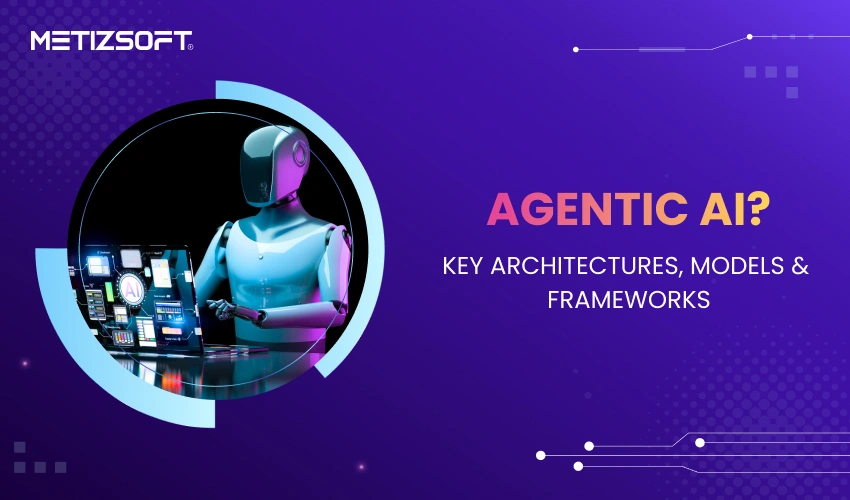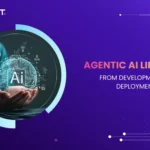
Table of Contents
Introduction
AI is now beyond only automation, answering questions, or solving complex tasks. It’s moving toward something more purposeful: systems that can think, decide, and act with clear objectives. This shift is driving the rise of Agentic AI, a concept that’s becoming the foundation of next-generation AI systems.
Businesses today are looking for intelligent tools that don’t just respond to inputs but take initiative. Agentic AI is helping create next-gen systems by combining machine learning, natural language understanding, and large language models into one goal-driven framework.
In this blog, we’ll walk through what makes Agentic AI different, how it works, what frameworks power it, and how it’s shaping future applications. If you’re exploring scalable, intelligent automation or planning to hire AI developers to create AI-powered next-gen applications, then this blog is your practical guide.
What is Agentic AI? A Quick Introduction
Agentic AI refers to artificial intelligence that acts like an independent agent. Think of it as a digital assistant that doesn’t just wait for instructions; it figures out what needs to be done and does it.
Unlike regular AI, which typically works in response to commands or triggers, Agentic AI can make choices, follow goals, and adjust its behavior based on the situation. A perfect example for this context is a robot that vacuums when you press a button and one that senses your schedule, figures out the best time to clean, and alerts you when it completes the task.
What sets Agentic AI apart is its ability to:
- Make goals and pursue them
- Break down tasks into smaller steps
- Learn from the results
- Work independently without constant supervision
All of this is made possible by combining several powerful technologies.
Key Mechanisms Behind Agentic AI
Agentic AI is built on layers of smart technology working together. Here are the key building blocks:
Machine Learning (ML): Machine Learning gives Agentic AI the ability to learn from data. It helps the system recognize patterns and improve over time. For example, if an Agentic AI system manages your emails, it learns which ones are most important to you by observing your behavior.
Natural Language Processing (NLP): NLP allows the system to understand and respond to human language. This is how it interprets your messages, instructions, or feedback in plain language. Agentic AI uses NLP to talk with users, search for information, or even summarize reports.
Large Language Models (LLMs): LLMs (like ChatGPT or GPT-4) are the brains behind most conversational AI systems today. They allow Agentic AI to generate meaningful responses, write content, or make decisions. But in Agentic AI, LLMs go one step further; they don’t just respond; they help drive action.
When these technologies come together, they create a smart agent that can think, understand, and act with a purpose.
Understanding Different Agentic AI Models
Each Agentic AI has its unique representation. Let’s look at a few well-known types and what they do.
- ReAct (Reason + Act): This model thinks out loud. It reasons through the task step-by-step and decides what action to take at each stage. It is ideal for tasks where logic matters, like debugging code or solving customer queries.
- AutoGPT: AutoGPT takes a goal and runs with it without micromanaging. It breaks the goal into subtasks, executes them, and adjusts as it goes. It is helpful for content writing, marketing automation, and research.
- BabyAGI: A lightweight version of autonomous AI, BabyAGI is great for task management. It creates a to-do list, handles tasks one by one, and adds new ones as needed. It’s like a super-organized AI assistant.
- AgentGPT: This model allows users to define a goal, and the AI handles the rest. It runs multiple agents that work together toward the same objective. Great for handling complex operations with minimal input.
Each of these Agentic AI models brings something unique to the table, depending on the use case and level of autonomy required.
The Architecture Behind Agentic AI
The structure of the Agentic AI architecture is designed for autonomy and adaptability. Here’s how the process typically flows:
- Input Gathering – The initial stage where AI collects context from users, data sources, or previous tasks.
- Goal Planning – This is the second stage, which defines the objective and outlines the steps required to reach it.
- Action Execution – The system performs actions in sequence, using tools, APIs, or logic.
- Outcome Evaluation – It measures the results and adjusts future steps accordingly.
This architecture supports the ongoing loop of round setting, action, and learning. It seamlessly scales, customizes, and performs without micromanagement.
Agentic AI’s Key Frameworks Explained
Agentic AI frameworks are the equipment and platforms that help developers create these smart agents. These frameworks have completed modules that handle planning, decision-making, and learning.
Let’s break it down into plain ideas:
- LangChain: This is a popular framework built by combining LLMs with tools, APIs, and memory. It helps developers build chains of logic that an agent can follow.
- AutoGen: It supports the creation of multiple AI agents that can seamlessly collaborate to solve complex problems.
- CrewAI: Designed for group-based agents that communicate with each other. Think of it as a team of bots working together toward a common goal.
- MetaGPT: Inspired by software engineering principles, MetaGPT can structure tasks and code with clarity and precision.
All these frameworks give AI development companies and developers the edge they need to make Agentic AI development services faster, smoother, and more scalable.
Emerging Trends and Future of Agentic AI
The evolution of Agentic AI has only started. Here are a few ideas shaping its future:
- Industry-specific AI agents: Tailored for sectors like healthcare, fintech, eCommerce, and logistics.
- Contextual behavior adaptation: Agents that change tone, style, or actions based on user needs or business settings.
- Self-improving loops: Systems that not only learn from results but adjust their own internal logic to perform better.
- Cross-agent collaboration: Multiple agents solving large-scale, multi-step problems in coordination.
These possibilities are drawing interest from companies looking to build smarter digital products. The push to hire AI developers who specialize in agent-based systems is rising fast, especially in automation, content creation, and operations.
Agentic AI is Just Getting Started
The world of Agentic AI is fast-forwarding with a plethora of innovations in line. As businesses explore smarter systems, Agentic AI architecture, frameworks, and models are becoming essential tools. These are not just AI systems that understand language — they act, learn, and improve.
From improving customer service to managing internal workflows, Agentic AI is opening up many new possibilities for innovation and efficiency. Companies looking to stay ahead are now turning to Agentic AI development services to unlock real value from their data and digital systems.
If you are ready to build smart, autonomous solutions that go beyond simple automation, it is time to hire AI developers who understand how to bring Agentic AI to life. Let’s build the future with intelligent agents, one at a time!
AboutManthan Bhavsar
Related Posts
What is The Importance of On-Demand Taxi Booking Apps & How Much Does it Cost to Develop?
The development of the cab booking industry is rapidly growing, and its service has become essential across many countries....
How to Update Product Options in Product Variants in Shopify?
This has been a common issue that many of you have encountered lately. And it is entirely understandable, as updating product...

